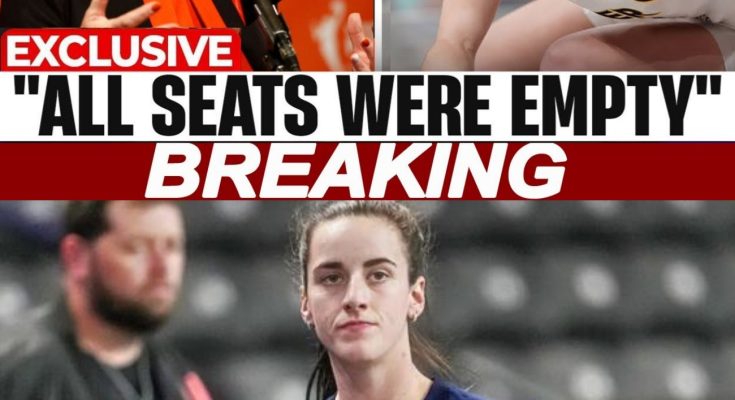Just a few months ago, the WNBA was buckling in for a parade. Ratings climbing. Ticket sales booming. Jerseys—especially those with “Clark” on the back—vanishing before the ink could dry. Indiana Fever games felt less like regular season basketball and more like a Taylor Swift world tour stop.
Yet as if scripted by the universe for maximum irony, it was a single muscle—a quad, not a bone—that dropped the curtain. Caitlin Clark, injured and suddenly benched, and with her absence, came shockwaves that no league executive, team owner or even rival player could truly brace for.

Plot Twist: Superstardom Has Risks
Kathy Engelbert and the league’s leadership thought they had a plan. Let’s lean in, they figured. Let the play be physical. Let the drama bake. Stars get bruised, but the fans love it—right?
But after Clark took a “game seven of the NHL finals” body check, the real drama wasn’t on the court; it was in the stands (and on social media). Fans didn’t just boo or grumble. They staged digital walkouts, threatened boycotts, and declared the league dead to them until their idol returned—like Black Friday customers denied their coupons.
Plot twist: The WNBA, in seeking equality and edge, discovered that throwing elbows at your MVP might hit your bottom line harder than your target’s soft tissue.
In Absentia: The Clark Effect
Official memo: Clark is out two weeks with a strained quadriceps. It’s no torn ACL, no career crisis—a minor muscle, a brief hiatus. But for the league, it may as well have been the gravity yanked out of the earth. Suddenly, the “Caitlin Clark Show” is off the air. What happens next?
Fans lose it. Fever faithful and casual viewers develop the emotional resilience of a soap opera character: “This league ain’t worth it without her. Boycott!” Some act as if the WNBA itself invaded their home and stole their family heirlooms.
The league panics quietly. Behind closed doors, executives desperately try to convince sponsors and TV partners all is well. Spoiler: It’s not.
Other stars left in the lurch. The rest of the league—A’ja Wilson, Aliyah Boston, Kelsey Mitchell—are still out there grinding, dropping double-doubles, breaking a sweat. But Twitter only responds, “Not now, sweetie.”
The Fever’s New Normal: Duct Tape and Desperation
Indiana, suddenly minus their golden goose, endures a team-wide stress test. Boston is rebounding like she’s exorcising ghosts. Mitchell, running the floor at maximum output, might actually have a secret third lung. Coach Stephanie White, meanwhile, musters up Hunger Games-level creativity, rewriting game plans on the fly and hoping for an upset.
The Fever have gone from “instant contender” to “please, just keep us on ESPN,” at least for a couple of weeks. But let’s not kid ourselves—Clark’s shadow looms.
The Business Risks: All Eggs, One Basket
Here’s what the league’s unfolding “drama” reveals: The WNBA built its current boom on Clark, betting that her presence would elevate the product. And in many ways, that gambit paid off.
Attendance soared.
Merch sold out.
TV and social clips went viral.
But in tying so much of the league’s energy, revenue, and narrative to one rookie’s presence, the WNBA made itself vulnerable. In her absence, they’re discovering the risk of mono-superstardom: when the queen leaves, so does the court.
Leadership’s Bind: Protect the Star, or the League?
Let’s call it what it is: a self-inflicted wound. Officials and administrators let “physical play” cross the line into targeted abuse. That toughness, they thought, would build buzz and equality—the league’s behemoth rookie facing veteran fire. Instead, they got bad optics, fan fury, and now, millions tuning out.
Fans see their star get hammered nightly, then sidelined with a “minor” injury, and think—why even watch? Meanwhile, role players and other starters sigh, “We exist too” (a statement as likely to trend as a dial-up modem).
The Fans: Vocal, Loyal, and Unforgiving
No modern sports movement has seen a rookie’s fans quite like Clark’s. Fever fans don’t just watch; they evangelize. They organize, trend, and treat Clark as untouchable—like a crossover of K-pop fans and Michael Jordan stans on Red Bull.
Remove Clark from the equation, and it’s not just indifference—it’s outright revolt. They boycott, they prod, they meme, and they let the league know: This was never about “growing the game.” It was about HER.
Is This the New Normal? Or a Wakeup Call?
If Clark returns healthy and rolls back into “SportsCenter Top 10” mode, all may be forgiven. Ratings, ticket sales, and Twitter threads will once again revolve around her. But if her absence lingers—or if the next physical defender does lasting harm—the WNBA will have to answer for leaning so hard into a single star, both with fans and sponsors.
For league brass, this “minor” injury wasn’t a blip. It was a warning shot. Ignore the warning, and the “Caitlin Clark Era” may be remembered not for what she brought to the game, but for how poorly the league protected its best asset.
Full Video:
Conclusion: Protect Your MVP—Or Pay the Price
The WNBA couldn’t have scripted this chaos better. They wanted drama; they got crisis. They wanted a star-driven surge; they got a stark lesson in the dangers of over-dependence.
When your cash-cow rookie becomes a nightly highlight reel for everything wrong with your officiating and brand protection, don’t be surprised when fans don’t just stop clapping—they storm the exits.
The applause was thunderous. The silence is even louder.


